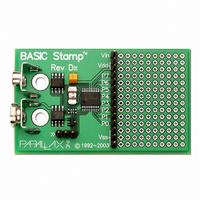27100 Parallax Inc, 27100 Datasheet - Page 8

27100
Manufacturer Part Number
27100
Description
BASIC STAMP REV DX MODULE
Manufacturer
Parallax Inc
Type
Microcontrollerr
Datasheet
1.27100.pdf
(23 pages)
Specifications of 27100
Contents
Board
Product
Microcontroller Basic Stamps
Operating Supply Voltage
5 to 15 V
Board Size
63.5 mm x 38.1 mm x 12.7 mm
For Use With/related Products
BASIC Stamp®
Lead Free Status / RoHS Status
Lead free / RoHS Compliant
Available stocks
Company
Part Number
Manufacturer
Quantity
Price
Part Number:
271000-51300730
Manufacturer:
DENSO
Quantity:
20 000
STAMP FAQS
What are the main differences between the BASIC Stamps?
Is the BASIC Stamp II better than the BASIC Stamp I?
Is the BASIC Stamp IIsx better than the BASIC Stamp II?
Last Revised On: 7/21/00
The BASIC Stamp I has 8 I/O pins, room for 80 to 100 lines of code, executes approximately 2000 instructions
per second and requires a parallel interface for programming. The BASIC Stamp II has 16 I/O pins, 2 dedicated
serial port pins (1 input, 1 output), room for 500 to 600 lines of code, executes approximately 4000 instructions per
second and requires a serial interface for programming. The BASIC Stamp IIsx has 16 I/O pins, 2 dedicated serial
port pins (1 input, 1 output), room for 4000 lines of code, executes approximately 10000 instructions per second
and requires a serial interface for programming For a more detailed comparison, refer to the language differences
page and review the BASIC Stamp I to BASIC Stamp II Conversion document on our web site:
http://www.parallaxinc.com/stamps/langdiff. There is also a comparison chart at
Yes and no, depending on your application. The BASIC Stamp II has twice the number of I/O pins, twice the
execution speed, 5 times the memory (code) space, a serial port and 5 times the resolution on time sensitive
commands. In many cases, the BASIC Stamp II fits applications better than the BASIC Stamp I. In some cases,
however, this is not true. For example, you may have a need for only a couple of inputs and outputs with which you
need to perform relatively simple, non speed-critical tasks. This is a perfect application for the BASIC Stamp I; the
BASIC Stamp II would be overkill if used in this way. A slightly different example would be if you have a variable
pulse width signal you need to monitor. The BASIC Stamp I can detect and measure a pulse as little as 10 µS wide
and as long as 0.65535 seconds wide. The BASIC Stamp II has 5 times the resolution, so it can measure a pulse
as little as 2 µS wide, however, only as long as 0.13107 seconds wide. While the better resolution may be helpful,
the smaller maximum pulse width measuring capability may prove disadvantageous to your application.
Yes and no, depending on your application. The BASIC Stamp IIsx executes instructions 2.5 times as fast, has 8
times the memory (code) space and 2.5 times the resolution on time sensitive commands. In some cases, the
BASIC Stamp IIsx fits applications better than the BASIC Stamp II. For example, you may have a need for
additional program space that doesn’t exist in the Stamp II. Another example would be if you have a variable pulse
width signal you need to monitor. The BASIC Stamp II can detect and measure a pulse as little as 2 µS wide and
as long as 0.13107 seconds wide. The BASIC Stamp IIsx has 2.5 times the resolution, so it can measure a pulse
as little as 800 nS wide, however, only as long as 0.05243 seconds wide. While the better resolution may be
helpful, the smaller maximum pulse width measuring capability may prove disadvantageous to your application. A full
comparison of the Stamps can be found at
the end of this
PROGRAMMING INFORMATION
document.
the end of this
document.
Page: 8





















